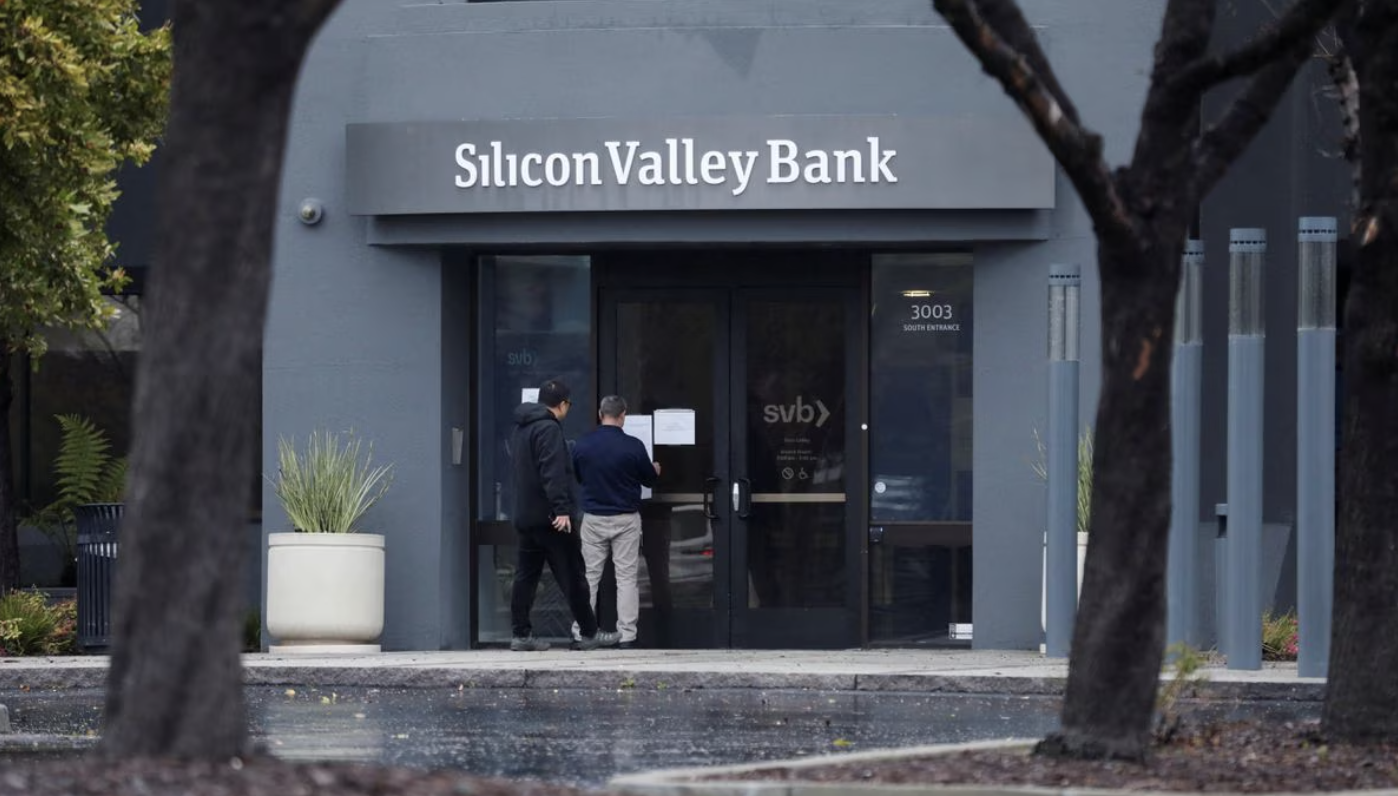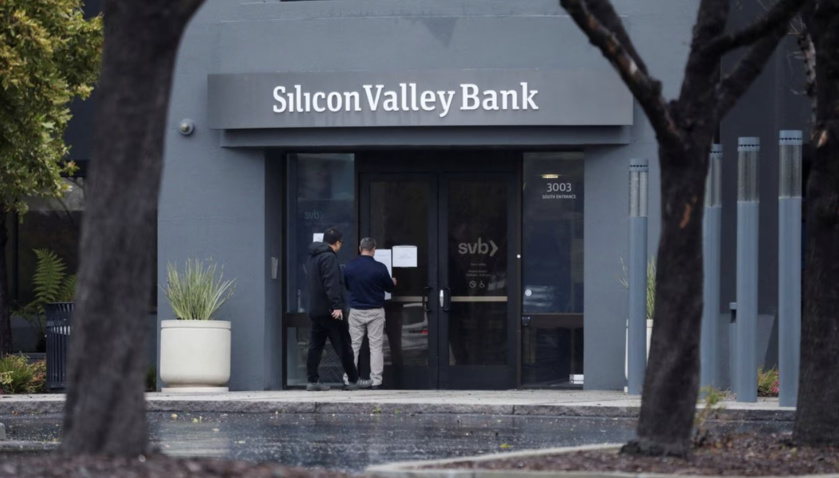
What has happened with SVB?
- Silicon Valley Bank (SVB) experienced a massive drop in its stock value of over 60% on March 9th, following several significant announcements by the bank the previous day
- Firstly, the management revised their estimation for customer deposit withdrawals in Q1 to a higher rate
- Secondly, they sold off most of their Available for Sale (AFS) securities at a loss of $2 billion, which was unexpected since it was believed that they would explore other avenues to increase liquidity before selling securities at a loss
- Thirdly, the bank declared a capital raise to replenish its liquidity. As a result, concerns over the bank’s solvency increased, resulting in higher deposit withdrawals that worsened the share price decline
- On March 10th, the bank, which had $212bn of assets, failed with spectacular speed after most of the bank’s depositors accelerated withdrawals
Why does this collapse matter?
- Banking is inherently a highly leveraged business – equity can be as little as 3% to 4% of total assets. This means any loss in the value of assets quickly impacts bank capital ratios and even solvency
- The collapse of SVB has been the largest failure of a US bank since the 2008 financial crisis, and its rapid unravelling has blindsided the banking industry after years of stability
- This situation is not only relevant for the banking industry, as SVB’s customer base was dominated by technology start-ups and the venture capital firms that fund them. SIVB publicly stated in 2021 that nearly half of all US venture-backed start-ups were customers
What is the potential impact on the Banking sector?
- The potential impact on the banking sector is not expected to have a direct contagion effect due to the particularities of SVB’s business and cash management in recent quarters. The broader banking industry has a more diversified deposit base with an average account size that falls within the existing FDIC guarantee
- Moreover, large entities are now far better capitalised than in the years that preceded the GFC and have seen their margins improve after years of low-interest rates – as reflected in their results in recent quarters
- However, the fear caused by the collapse led to a correction in several players already in a complex situation. This is particularly intense for US regional banks, which shares tumbled on fears of deposit outflows, despite pledges by President Joe Biden to do “whatever is needed” to protect depositors and the Fed and Treasury’s actions to boost lenders’ access to quick cash
- In Europe, supervisors closely monitor interest rate risks and discourage banks from having large books of unhedged treasuries as SVB did. Generally, European banks are in a stronger position and have more resilient business models
- Against this backdrop, yesterday’s sell-off led to a short-term impact on the European financial sector, which was more acute on those entities that were already sitting in a complex position for reasons unrelated to the current turmoil
- In the UK, the risk has been mitigated further by SVB UK being acquired for a token of £1 by HSBC. UK authorities, namely the Bank of England and Treasury, have stated that no depositors are expected to lose any money from this deal, which should be a highly capital-accretive transaction for HSBC once the dust has settled
- Regarding the potential effects of this situation on monetary policy, we believe central banks will need to find a balance between fighting inflation and ensuring that financial conditions don’t tighten excessively due to a potential increase in risk aversion
- With respect to the ECB, in particular, we believe it is likely that it will raise rates by tomorrow. However, this action will probably be accompanied by language emphasizing that further moves will depend on how the situation develops from here, both in terms of price pressures and financial stability factors
What is the potential impact on the tech space?
- It is likely that capital deployment is reduced and needs to rely mostly on equity. Valuations will continue to be lower, leading to a mismatch of sell-side expectations and appetite. Structure will play a bigger role now. Also, the flight-to-quality will be more pronounced. The uncertainty will also play a factor in slowing things down in the near term
- Unclear if this affects PE/VC firm liquidity from LP funds at this point – there is still circa $2Tn of PE/VC capital, but LP conservatism could lead to a reduction. At a minimum, this will likely drive continued tightening of investments and a push to have their portfolio companies cut burn
- Last year, all strong private companies were guided to raise 2-3+ years of cash and continue spending to grow, and they are all using debt to complement their capital stack, including SVB for VC-backed cos. The debt will be even tighter now, and we shall see if the guidance from owners is to continue spending or increase cost cuts
- There will be continued layoffs and potentially an acceleration in the start-up ecosystem, which employs a large population of tech workers. The initial layoffs we have seen have been with the mega-cap Tech players
- US and globally, the VC ecosystems will tighten up investing and will focus more on quality firms that can scale and be capital efficient. The early-stage investments will continue the drought, and metrics will be critical
- Contagion in Europe is more likely to come from technology companies, including some with US headquarters suffering direct losses from SVB or scaling back their growth ambitions after the fright they have suffered this week, causing secondary slowdown effects
What about deal-making?
- We are in a context where financing conditions are more demanding, with banks taking a more conservative and selective approach to corporate lending and LBOs. Likely, this is further extended in the current context
- The credit tightening and the abrupt market correction will probably have an impact on deal-making activity while companies and investors properly assess the situation
- The potential impact on the tech space is that capital deployment will be reduced, and there will be a need to rely mostly on equity. Valuations will continue to be lower, leading to a mismatch of sell-side expectation and appetite, and structure will play a bigger role now
- Finally, the correction and market instability will likely affect the window of Capital Markets activity
- With this in mind, we may continue to see companies and investors expanding their traditional deal approaches to either de-risk deals and investments or achieve growth through a wider range of synergies. For example, Pfizer announced yesterday a $229-a-share cash offer to buy oncology-focused biotech Seage, totalling $43bn
- With an abundance of dry powder still available, private equity may also opt for increasing full equity deals to avoid being stung by expensive debt options
------------------------------------------------------------------------------------------------
This communication has been prepared by Alantra, and the information contained herein shall only be distributed as permitted by applicable law and ALANTRA specifically forbids its redistribution in whole or in part without its prior written permission. Nothing in this communication constitutes a representation from ALANTRA of any investment strategy or recommendation contained herein is suitable or appropriate to a recipient’s individual circumstances or otherwise constitutes a personal recommendation.
This communication is published solely for information purposes, and it does not constitute an advertisement. The communication entails subjective judgments. In particular, many of the criteria used are based, in full or in part, on estimates concerning the future. In light of the inherent uncertainties of any information concerning the future, some of these hypotheses might not materialize as defined herein. No representation or warranty, either expressed or implied, is provided in relation to the accuracy, completeness or reliability of the information contained herein, nor it is intended to be a complete statement or summary of the securities or financial markets referred to in this communication.
The information contained herein has been extracted from public sources that ALANTRA considers reliable and is not responsible for its truthfulness or accuracy. This communication should not be regarded by recipients as a substitute for the exercise of their own judgement. The analysis contained herein is based on numerous assumptions, hypothesis and forecasts. Different assumptions could result in materially different results. ALANTRA is under no obligation to updated or keep current the information contained in this communication. The recipients should note that the financial market is fluctuating and as such is subject to variations. The price of investments (which may be quoted in illiquid markets) may change and the investor may not get back the amount initially invested. The figures contained herein relate to the past. Past performance is not a reliable indicator of future results.
Neither Alantra, nor any of its respective group companies, shareholders, executives, managers and employees accepts any responsibility whatsoever for damages or losses that, directly or indirectly, may derive from the decisions that are adopted based on this communication, nor from the use that the recipients may make of it.
- Silicon Valley Bank (SVB) experienced a massive drop in its stock value of over 60% on March 9th, following several significant announcements by the bank the previous day
- Firstly, the management revised their estimation for customer deposit withdrawals in Q1 to a higher rate
- Secondly, they sold off most of their Available for Sale (AFS) securities at a loss of $2 billion, which was unexpected since it was believed that they would explore other avenues to increase liquidity before selling securities at a loss
- Thirdly, the bank declared a capital raise to replenish its liquidity. As a result, concerns over the bank’s solvency increased, resulting in higher deposit withdrawals that worsened the share price decline
- On March 10th, the bank, which had $212bn of assets, failed with spectacular speed after most of the bank’s depositors accelerated withdrawals
Why does this collapse matter?
- Banking is inherently a highly leveraged business – equity can be as little as 3% to 4% of total assets. This means any loss in the value of assets quickly impacts bank capital ratios and even solvency
- The collapse of SVB has been the largest failure of a US bank since the 2008 financial crisis, and its rapid unravelling has blindsided the banking industry after years of stability
- This situation is not only relevant for the banking industry, as SVB’s customer base was dominated by technology start-ups and the venture capital firms that fund them. SIVB publicly stated in 2021 that nearly half of all US venture-backed start-ups were customers
What is the potential impact on the Banking sector?
- The potential impact on the banking sector is not expected to have a direct contagion effect due to the particularities of SVB’s business and cash management in recent quarters. The broader banking industry has a more diversified deposit base with an average account size that falls within the existing FDIC guarantee
- Moreover, large entities are now far better capitalised than in the years that preceded the GFC and have seen their margins improve after years of low-interest rates – as reflected in their results in recent quarters
- However, the fear caused by the collapse led to a correction in several players already in a complex situation. This is particularly intense for US regional banks, which shares tumbled on fears of deposit outflows, despite pledges by President Joe Biden to do “whatever is needed” to protect depositors and the Fed and Treasury’s actions to boost lenders’ access to quick cash
- In Europe, supervisors closely monitor interest rate risks and discourage banks from having large books of unhedged treasuries as SVB did. Generally, European banks are in a stronger position and have more resilient business models
- Against this backdrop, yesterday’s sell-off led to a short-term impact on the European financial sector, which was more acute on those entities that were already sitting in a complex position for reasons unrelated to the current turmoil
- In the UK, the risk has been mitigated further by SVB UK being acquired for a token of £1 by HSBC. UK authorities, namely the Bank of England and Treasury, have stated that no depositors are expected to lose any money from this deal, which should be a highly capital-accretive transaction for HSBC once the dust has settled
- Regarding the potential effects of this situation on monetary policy, we believe central banks will need to find a balance between fighting inflation and ensuring that financial conditions don’t tighten excessively due to a potential increase in risk aversion
- With respect to the ECB, in particular, we believe it is likely that it will raise rates by tomorrow. However, this action will probably be accompanied by language emphasizing that further moves will depend on how the situation develops from here, both in terms of price pressures and financial stability factors
What is the potential impact on the tech space?
- It is likely that capital deployment is reduced and needs to rely mostly on equity. Valuations will continue to be lower, leading to a mismatch of sell-side expectations and appetite. Structure will play a bigger role now. Also, the flight-to-quality will be more pronounced. The uncertainty will also play a factor in slowing things down in the near term
- Unclear if this affects PE/VC firm liquidity from LP funds at this point – there is still circa $2Tn of PE/VC capital, but LP conservatism could lead to a reduction. At a minimum, this will likely drive continued tightening of investments and a push to have their portfolio companies cut burn
- Last year, all strong private companies were guided to raise 2-3+ years of cash and continue spending to grow, and they are all using debt to complement their capital stack, including SVB for VC-backed cos. The debt will be even tighter now, and we shall see if the guidance from owners is to continue spending or increase cost cuts
- There will be continued layoffs and potentially an acceleration in the start-up ecosystem, which employs a large population of tech workers. The initial layoffs we have seen have been with the mega-cap Tech players
- US and globally, the VC ecosystems will tighten up investing and will focus more on quality firms that can scale and be capital efficient. The early-stage investments will continue the drought, and metrics will be critical
- Contagion in Europe is more likely to come from technology companies, including some with US headquarters suffering direct losses from SVB or scaling back their growth ambitions after the fright they have suffered this week, causing secondary slowdown effects
What about deal-making?
- We are in a context where financing conditions are more demanding, with banks taking a more conservative and selective approach to corporate lending and LBOs. Likely, this is further extended in the current context
- The credit tightening and the abrupt market correction will probably have an impact on deal-making activity while companies and investors properly assess the situation
- The potential impact on the tech space is that capital deployment will be reduced, and there will be a need to rely mostly on equity. Valuations will continue to be lower, leading to a mismatch of sell-side expectation and appetite, and structure will play a bigger role now
- Finally, the correction and market instability will likely affect the window of Capital Markets activity
- With this in mind, we may continue to see companies and investors expanding their traditional deal approaches to either de-risk deals and investments or achieve growth through a wider range of synergies. For example, Pfizer announced yesterday a $229-a-share cash offer to buy oncology-focused biotech Seage, totalling $43bn
- With an abundance of dry powder still available, private equity may also opt for increasing full equity deals to avoid being stung by expensive debt options
------------------------------------------------------------------------------------------------
This communication has been prepared by Alantra, and the information contained herein shall only be distributed as permitted by applicable law and ALANTRA specifically forbids its redistribution in whole or in part without its prior written permission. Nothing in this communication constitutes a representation from ALANTRA of any investment strategy or recommendation contained herein is suitable or appropriate to a recipient’s individual circumstances or otherwise constitutes a personal recommendation.
This communication is published solely for information purposes, and it does not constitute an advertisement. The communication entails subjective judgments. In particular, many of the criteria used are based, in full or in part, on estimates concerning the future. In light of the inherent uncertainties of any information concerning the future, some of these hypotheses might not materialize as defined herein. No representation or warranty, either expressed or implied, is provided in relation to the accuracy, completeness or reliability of the information contained herein, nor it is intended to be a complete statement or summary of the securities or financial markets referred to in this communication.
The information contained herein has been extracted from public sources that ALANTRA considers reliable and is not responsible for its truthfulness or accuracy. This communication should not be regarded by recipients as a substitute for the exercise of their own judgement. The analysis contained herein is based on numerous assumptions, hypothesis and forecasts. Different assumptions could result in materially different results. ALANTRA is under no obligation to updated or keep current the information contained in this communication. The recipients should note that the financial market is fluctuating and as such is subject to variations. The price of investments (which may be quoted in illiquid markets) may change and the investor may not get back the amount initially invested. The figures contained herein relate to the past. Past performance is not a reliable indicator of future results.
Neither Alantra, nor any of its respective group companies, shareholders, executives, managers and employees accepts any responsibility whatsoever for damages or losses that, directly or indirectly, may derive from the decisions that are adopted based on this communication, nor from the use that the recipients may make of it.
------------------------------------------------------------------------
Disclaimer: The text above is a press release that was not written by Finyear.com.
The issuer is solely responsible for the content of this announcement.
Avertissement : Le texte ci-dessus est un communiqué de presse qui n'a pas été rédigé par Finyear.com.
L'émetteur est seul responsable du contenu de cette annonce.
-------------------------------------------------------------------------
Les avis financiers et/ou économiques présentés par les contributeurs de Finyear.com (experts, avocats, observateurs, bloggers, etc...) sont les leurs et peuvent évoluer sans qu’il soit nécessaire de faire une mise à jour des contenus. Les articles présentés ne constituent en rien une invitation à réaliser un quelconque investissement.
The financial and/or economic opinions presented by Finyear.com contributors (experts, lawyers, observers, bloggers, etc.) are their own and may change without the need to update the content. The articles presented do not constitute an invitation to make any investment.
Disclaimer: The text above is a press release that was not written by Finyear.com.
The issuer is solely responsible for the content of this announcement.
Avertissement : Le texte ci-dessus est un communiqué de presse qui n'a pas été rédigé par Finyear.com.
L'émetteur est seul responsable du contenu de cette annonce.
-------------------------------------------------------------------------
Les avis financiers et/ou économiques présentés par les contributeurs de Finyear.com (experts, avocats, observateurs, bloggers, etc...) sont les leurs et peuvent évoluer sans qu’il soit nécessaire de faire une mise à jour des contenus. Les articles présentés ne constituent en rien une invitation à réaliser un quelconque investissement.
The financial and/or economic opinions presented by Finyear.com contributors (experts, lawyers, observers, bloggers, etc.) are their own and may change without the need to update the content. The articles presented do not constitute an invitation to make any investment.

















